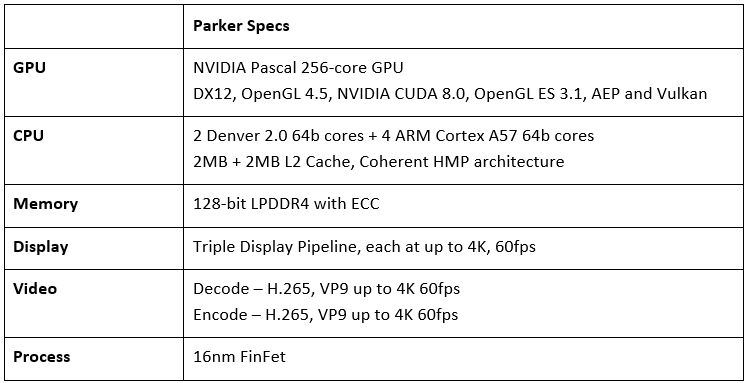Nvidia also detailed its new Parker chip at the Hot Chips conference too, but essentially all you need to know is that Parker is a 16nm FinFET ARM V8 CPU with two Denver 2 + 4x A57 Coherent HMP and with a 256 Cuda core Pascal Geforce GPU.
Just a quick view of the CPU's configuration gives you a clear signal that this SoC is unlikely to end up in any tablet. Two Denver 2 + 4x Cortex A57 seems like something that need to be plugged in to a power source all the time such as an autonomous car, a next generation shield console or the rumored Nintendo NX console.
The Nvidia Pascal 256-Core GPU supports DirectX 12, OpenGL 4.5, Nvidia Cuda 8.0, Open GL ES 3.1, ARP and Vulkan. This is the same number of cores as Nvidia had with the Erista, Tegra X1 but of course Pascal cores are much more efficient than the Maxwell and they should be able to clock them higher. It was rather clear with Tegra X1 that this SoC will not make it to any tablet shaped device due to its high power consumption and the Google Pixel C design win was the best that Nvidia could achieve.
The Denver 2 and Cortex A57 have 2MB + 2MB L2 cache in coherent HMP architecture and the SoC supports 128-bit LPDDR4 with ECC.
The GPU can decode and encode H.265, VP9 both up to 4K at 60FPS. It also supports a 12 Megapixel camera sensor.
Two Parker SoCs power the Drive PX platform as Nvidia wants to power deep learning applications, even in a motor car.
More than 80 carmakers, tier one suppliers and university research centers around the world are now using our DRIVE PX 2 system to develop autonomous vehicles. This doesn’t mean that Nvidia will have as many design wins, but it looks like a big opportunity.
The Volvo XC90 is the first vehicle supporting DRIVE PX 2 and since Parker delivers up to 1.5 teraflops of performance for deep learning-based self-driving AI cockpit systems, Volvo could end up with a rather safe self-driving car. Since DRIVE PX 2 has two Parker SoCs, you end up with 3 teraflops of performance for the deep learning, self-driving AI cockpit system.
The combination of two Parker SoCs with a total of four CPU cores each and 2x256 Cuda cores, means that the Drive PX 2 might deliver 24 trillion deep learning operations per second to run the most complex deep learning based inference algorithms.
Parker supports dual-CAN (controller area network) interface, a standard connector in the car industry and Gigabit Ethernet to transport audio and video streams.




